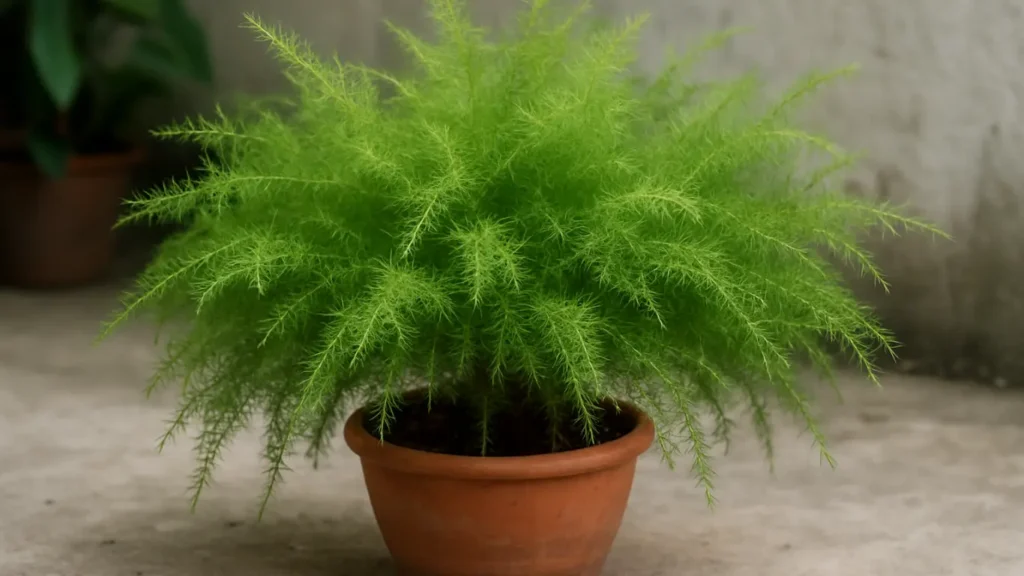
Asparagus Ferns, despite their delicate, fern-like appearance, aren’t true ferns but are fascinating members of the Asparagus genus. This comprehensive guide will demystify their care, covering the most popular types like Asparagus setaceus (Plumosa Fern), Asparagus densiflorus ‘Sprengeri’ (Sprenger’s Fern), and ‘Myersii’ (Foxtail Fern), ensuring you can grow them beautifully indoors or out.
Table of Contents
Asparagus Fern General Care at a Glance (For Most Common Types)
Here’s your quick reference for asparagus fern care essentials:
• Light: Bright, indirect light is ideal. Tolerates some morning sun.
• Watering: Keep soil consistently moist, but not waterlogged, during the growing season. Reduce in winter.
• Soil: Well-draining, rich potting mix.
• Humidity: Prefers high humidity. Mist regularly, use pebble trays, or a humidifier.
• Temperature: Average room temperatures (65-75°F / 18-24°C). Protect from drafts and extreme cold.
• Fertilizing: Feed with a balanced liquid fertilizer every 2-4 weeks during spring/summer.
• Toxicity: Berries (and sometimes foliage) are toxic to pets and humans if ingested.
Important Note on Types: While general asparagus fern indoor care principles are similar across varieties, specific needs can vary slightly between different species and cultivars, which will be detailed below.
What Kind of Asparagus Fern Do You Have? Identifying Common Types
While often grouped together, ‘Asparagus Fern’ commonly refers to a few key species and cultivars within the Asparagus genus. Knowing your specific asparagus fern plant can help fine-tune your care approach:
Asparagus setaceus (syn. Asparagus plumosus) – Plumosa Fern / Common Asparagus Fern
This elegant variety features fine, feathery, flat sprays of “foliage” (technically called cladodes) with a natural climbing habit. The delicate appearance makes it a popular choice for decorative arrangements and as a houseplant.
Specific Care Nuances: May prefer slightly more shade than other varieties and benefits from support structures when allowed to climb. The fine foliage is particularly sensitive to low humidity.
Asparagus densiflorus ‘Sprengeri’ – Sprenger’s Asparagus Fern
Characterized by gracefully arching stems adorned with needle-like cladodes, this variety is frequently used in hanging baskets where its cascading growth pattern can be fully appreciated.
Specific Care Nuances: Can tolerate slightly more direct sunlight than other asparagus ferns and becomes more drought-tolerant once the tuberous root system is well-established.
Asparagus densiflorus ‘Myersii’ (or ‘Meyeri’) – Foxtail Fern
This striking variety produces upright, dense plumes that closely resemble foxtails, creating an architectural accent in container gardens and indoor displays.
Specific Care Nuances: Excellent for containers due to its compact, upright growth habit. The dense foliage creates a stunning focal point and requires consistent moisture to maintain its lush appearance.
Other Notable Asparagus “Ferns”
Asparagus virgatus (Tree Fern Asparagus) and other species are occasionally available, each with unique characteristics but similar basic care requirements.
| Common Name | Botanical Name | Key Identifying Features | Primary Use |
|---|---|---|---|
| Plumosa Fern | Asparagus setaceus | Fine, feathery flat sprays | Climbing houseplant, arrangements |
| Sprenger’s Fern | A. densiflorus ‘Sprengeri’ | Arching stems, needle-like foliage | Hanging baskets, ground cover |
| Foxtail Fern | A. densiflorus ‘Myersii’ | Upright plumes, dense growth | Container gardens, focal points |
Essential Asparagus Fern Care: Nurturing Health & Beauty
Light Requirements: The Balancing Act for Delicate Foliage
Asparagus fern care revolves around providing bright, indirect light that mimics their natural understory habitat. Position your plants near an east-facing window for gentle morning sun, or 3-4 feet from a south-facing window with sheer curtains filtering the light.
Signs of improper lighting:
- Too much direct sun: Yellowing or browning of cladodes, especially tips
- Too little light: Sparse, leggy growth and pale coloration
- Just right: Dense, vibrant green growth with good branching
Variety-specific notes: Sprenger’s asparagus fern can handle slightly more direct sunlight than the delicate Plumosa variety, while Foxtail ferns appreciate consistent bright light to maintain their dense plume structure.
Watering Wisely: Keeping Asparagus Ferns Perfectly Hydrated
Proper watering is crucial for asparagus fern indoor care success. These plants develop thick, tuberous roots that store water, but they still prefer consistently moist (not soggy) soil during the growing season.
Watering technique:
- Check soil moisture by inserting your finger 1-2 inches deep
- Water thoroughly when the top inch feels dry
- Allow excess water to drain completely
- Reduce watering frequency in winter when growth slows
Signs of watering issues:
- Overwatering: Yellow cladodes, musty soil smell, root rot
- Underwatering: Brown, crispy cladodes starting from tips, dropping foliage
The tuberous root system means established plants (especially Sprenger’s variety) can tolerate brief dry periods better than newly planted specimens.
Soil & Potting: The Foundation for Healthy Growth
Create the ideal growing medium by combining:
- 2 parts high-quality potting soil
- 1 part perlite or coarse sand for drainage
- 1 part compost or well-aged manure for nutrition
Repotting guidelines:
- Repot every 2-3 years or when roots become overcrowded
- Choose a pot only 1-2 inches larger than the current container
- Spring is the ideal time for repotting
- Handle the thick, fleshy roots gently to avoid damage
Humidity Heaven: Why Asparagus Ferns Crave Moisture in the Air
High humidity (40-60%) is essential for preventing the brown, crispy tips that plague many asparagus fern owners. These plants naturally grow in humid environments, and dry indoor air causes stress.
Effective humidity solutions:
- Pebble trays filled with water beneath the pot
- Regular misting (daily in dry conditions)
- Room humidifiers
- Grouping plants together to create microclimates
- Bathroom placement if lighting is adequate
Temperature & Airflow: Creating a Stable Environment
Maintain temperatures between 65-75°F (18-24°C) for optimal growth. Asparagus ferns are sensitive to:
- Cold drafts from windows or air conditioning
- Heat from radiators or heating vents
- Sudden temperature fluctuations
Provide gentle air circulation to prevent fungal issues, but avoid placing plants directly in the path of fans or air conditioning units.
Feeding Your Asparagus Fern: Nutrients for Lush Growth
During the active growing season (spring through early fall), feed your asparagus fern plant with a balanced, liquid fertilizer diluted to half strength every 2-4 weeks. Look for fertilizers with equal N-P-K ratios (such as 10-10-10 or 20-20-20).
Fertilizing schedule:
- March-September: Every 2-3 weeks with diluted liquid fertilizer
- October-February: Monthly or suspend feeding entirely
- Signs of over-fertilization: Salt buildup on soil surface, brown leaf tips despite adequate humidity

Advanced Asparagus Fern Management & Expansion
Pruning Asparagus Ferns: For Shape, Health & Rejuvenation
Regular pruning maintains plant health and appearance. Unlike true ferns, asparagus ferns can be cut back dramatically without harm.
Pruning techniques:
- Remove yellow or brown cladodes at any time by cutting back to the base
- Trim overgrown stems to maintain desired size and shape
- Perform major pruning in early spring before new growth begins
- Use clean, sharp scissors or pruning shears to prevent disease transmission
Rejuvenation pruning: Severely overgrown or declining plants can be cut back to 2-3 inches above soil level. New growth will emerge from the tuberous roots within weeks.
Propagating Asparagus Ferns: Creating New Plants
Division is the most reliable propagation method for asparagus ferns, best performed during repotting in spring.
Step-by-step division:
- Remove the plant from its container and gently shake off excess soil
- Locate natural divisions in the tuberous root system
- Use a clean, sharp knife to separate sections, ensuring each has roots and growing points
- Allow cut surfaces to dry for a few hours to prevent rot
- Plant divisions in fresh potting mix and water lightly
- Keep in bright, indirect light until new growth appears
Growing from seed: If your plant produces berries (small red or black fruits), seeds can be extracted and planted, though this process is slow and germination rates are often low.
Growing Asparagus Ferns Outdoors (Where Applicable)
In USDA zones 9-11, many asparagus ferns can survive year-round outdoors. In cooler climates, they make excellent summer patio plants.
Outdoor considerations:
- Gradually acclimate indoor plants to outdoor conditions over 7-10 days
- Provide morning sun with afternoon shade in hot climates
- Monitor watering needs more closely as outdoor conditions vary
- Important: Asparagus densiflorus species can become invasive in warm, humid climates. Check local regulations and consider container growing to prevent spread.
Asparagus Fern SOS: Identifying and Fixing Common Issues
| Problem | Likely Cause(s) | Solution(s) |
|---|---|---|
| Yellowing fronds/cladodes | Overwatering, natural aging, nutrient deficiency | Adjust watering, remove old growth, fertilize |
| Brown tips or overall browning | Low humidity, underwatering, direct sun exposure | Increase humidity, check watering, relocate |
| Needle/cladode drop | Stress from environmental changes, improper watering | Maintain consistent conditions, proper watering |
| Pest infestations | Spider mites, mealybugs, aphids | Increase humidity, insecticidal soap, systemic treatment |
| Leggy, sparse growth | Insufficient light, over-fertilization | Move to brighter location, reduce fertilizer |
Common pests and treatment:
- Spider mites: Increase humidity, spray with water, use insecticidal soap
- Mealybugs: Remove with alcohol-soaked cotton swabs, systemic insecticide for severe infestations
- Aphids: Spray off with water, insecticidal soap for persistent problems
Asparagus Fern Toxicity: A Warning for Pet Owners & Parents
Safety Alert: Asparagus fern berries are toxic to both pets and humans if ingested. The berries contain saponins that can cause:
In pets: Vomiting, diarrhea, abdominal pain, and skin irritation In humans: Stomach upset, skin irritation from plant sap
Safety measures:
- Place plants out of reach of children and pets
- Remove berries promptly when they appear
- Wear gloves when handling plants to avoid skin irritation
- Contact veterinarian or poison control if ingestion occurs
Your Top Asparagus Fern Questions Answered (Expert FAQ)
Why is my asparagus fern turning yellow/brown?
The most common causes include overwatering (leading to root rot), underwatering (causing stress), natural aging of older cladodes, low humidity, or excessive direct sunlight. Evaluate your care routine and environmental conditions to identify the specific cause.
Can asparagus ferns take full sun?
Most asparagus ferns prefer bright, indirect light and can be damaged by intense, direct sunlight. However, Sprenger’s asparagus fern can tolerate more direct sun than other varieties, especially morning sun. Gradually acclimate plants to increased light levels.
How often should I mist my asparagus fern?
Misting frequency depends on your home’s humidity levels. In dry conditions, daily misting helps, but ensure good air circulation to prevent fungal issues. Pebble trays or humidifiers provide more consistent humidity than misting alone.
Is asparagus fern a real fern?
No, despite the common name, asparagus ferns are not true ferns. They belong to the Asparagus genus in the Asparagaceae family and are more closely related to asparagus vegetables than to ferns.
Do asparagus ferns clean the air?
While asparagus ferns are not on NASA’s official air-purifying plants list, like most houseplants, they do contribute to improved indoor air quality through natural photosynthesis and transpiration processes.
How big do asparagus ferns get?
Size varies by species: Plumosa ferns can climb 6+ feet with support, Sprenger’s ferns typically reach 1-2 feet tall with 3-4 foot spread, and Foxtail ferns grow 1-3 feet tall and wide. Regular pruning maintains desired size.
Asparagus Ferns: Rewarding Additions to Your Plant Collection
Asparagus ferns offer unique beauty and relatively straightforward care once you understand their specific needs. Their feathery, elegant foliage adds texture and movement to any plant collection, while their tolerance for indoor conditions makes them excellent houseplants for both beginners and experienced gardeners.
The key to successful asparagus fern care lies in providing consistent moisture, high humidity, and bright indirect light while respecting their need for well-draining soil and protection from temperature extremes. By identifying your specific variety and tailoring care accordingly, you’ll be rewarded with lush, healthy plants that bring natural beauty to your indoor spaces.
Remember that these aren’t true ferns, but their unique charm and adaptability make them worthy additions to any plant lover’s collection. With proper care, your asparagus fern can thrive for years, potentially producing the small white flowers and colorful berries that add seasonal interest to these already captivating plants.
Which type of Asparagus Fern is your favorite? Share your growing tips or questions in the comments below!
Author
George Wine is a seasoned gardening expert with over 20 years of experience in the field of horticulture. His passion for plants and nature has driven his career, where he has honed his skills in various aspects of gardening, from landscape design to plant care. George holds a Master of Science in Horticulture from the University of California, Davis (UC Davis), a prestigious institution known for its research and advancements in plant science.
Throughout his career, George has worked with a diverse range of clients, offering tailored solutions to enhance outdoor spaces and create thriving gardens. His knowledge and expertise allow him to provide invaluable advice, ensuring that both novice and experienced gardeners achieve their gardening goals. Whether you’re looking for tips on sustainable gardening practices, innovative design ideas, or advice on specific plant species, George is here to help you cultivate the garden of your dreams.






